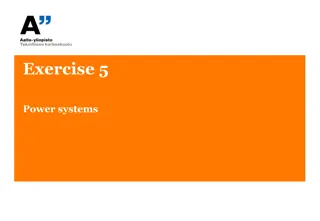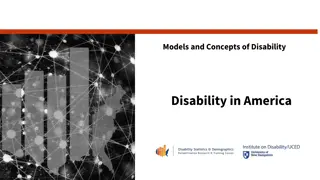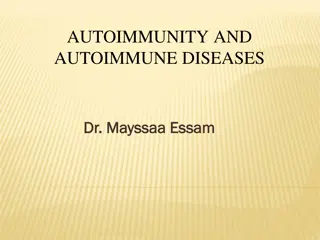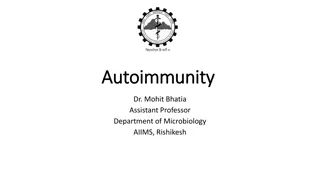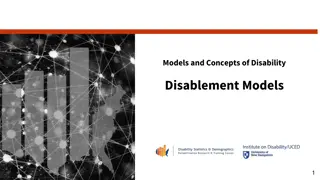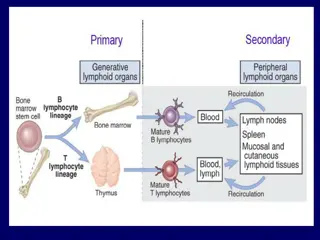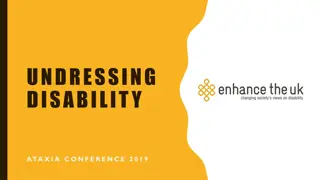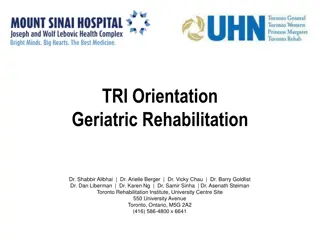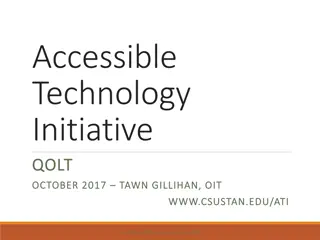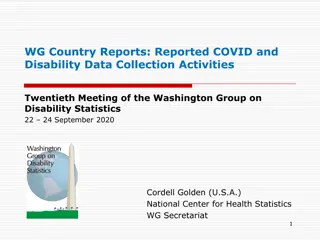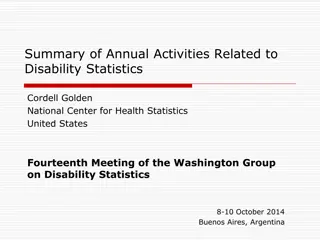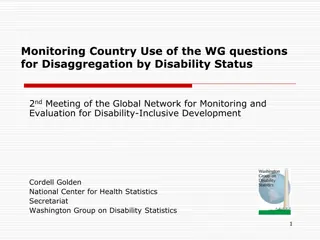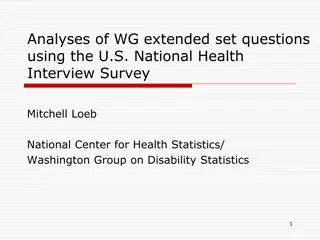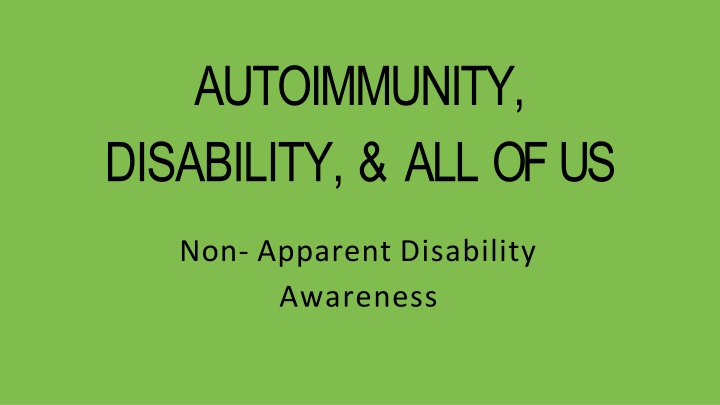
Autoimmunity, Disability, & All of Us: Non-Apparent Disability Awareness
It is crucial to remember that invisible conditions are often overlooked in healthcare. Post-COVID awareness of POTS has increased. Symptom management is key for conditions like POTS that have no cure. POTS is underdiagnosed and commonly co-occurs with other conditions, with identifiable symptoms like lightheadedness and exercise intolerance.
Download Presentation

Please find below an Image/Link to download the presentation.
The content on the website is provided AS IS for your information and personal use only. It may not be sold, licensed, or shared on other websites without obtaining consent from the author. If you encounter any issues during the download, it is possible that the publisher has removed the file from their server.
You are allowed to download the files provided on this website for personal or commercial use, subject to the condition that they are used lawfully. All files are the property of their respective owners.
The content on the website is provided AS IS for your information and personal use only. It may not be sold, licensed, or shared on other websites without obtaining consent from the author.
E N D
Presentation Transcript
AUTOIMMUNITY, DISABILITY, & ALL OF US Non- Apparent Disability Awareness
BACKGROUND Photo by Nathan Dumlao on Unsplash According to data published by UMass, It is estimated that 10% of people in the U.S. have a medical condition that could be considered invisible... (UMass, 2015). It is crucial to remember that just because something is invisible does not mean it is non-existent. Invisible conditions are still frequently overlooked, mishandled, and inadequately treated within the healthcare system.
COVID-19 PANDEMIC & AWARENESS OF POTS Photo by Luke Jones on Unsplash Public awareness increased following COVID-19 as professionals observed a significant number of individuals exhibiting symptoms of POTS after their recovery from the virus. Postural Orthostatic Tachycardia Syndrome refers to a group of symptoms that occur when an individual transitions from lying down to sitting, and then to standing. (NOTE--these are not the only instances when a person may experience symptoms.) Photo by IvanBE pratama on Unsplash
Symptom Management NO CURE DOESN T MEAN NO OPTIONS WHAT CAN YOU DO Postural Orthostatic Tachycardia Syndrome cannot be cured but there are actions someone can take to minimize disruptions as much as possible. Although there is currently no cure for Postural Orthostatic Tachycardia Syndrome (POTS), there are various management options. If it cannot be cured, why is management important? Symptom management can help improve quality of life. Here are a few things that should be in your toolbox: Compression garments Eating smaller meals more frequently Physical therapy to increase activity & exercise tolerance Medication Having a diverse treatment team is beneficial, particularly because POTS symptoms impact multiple areas of the body, including heart rate, blood flow, blood volume, and beyond.
POTS IS UNDER DIAGNOSED AND MISDIAGNOSED DUE TO SIMILAR OR IDENTICAL SYMPTOMS WITH OTHER CONDITIONS POTS AS A SINGULAR DIAGNOSIS AS WELL AS CO-OCCURRING Commonly seen co-occuring with POTs is: Ehlers-Danlos syndrome, Mast Cell activation syndrome, and Gastroparesis (note: these are only a few). COMMON SYMPTOMS OF POTS It's essential to recognize that although individuals must meet the diagnostic criteria, (symptoms presenting post standing) not everyone with POTS will have identical experiences due to the diverse range of symptoms associated with the condition. Experiencing the above conditions is not a diagnostic requirement, but they are frequently experienced together, as POTs falls under the umbrella of Dysautonomia, which describes a disorder of the autonomic nervous system. (Some) common symptoms of POTS are: lightheartedness (w/ or w/out syncope) palpitations exercise intolerance tremors & blurry vision
RESULT 48.2% of people diagnosed with POTs are also diagnosed with migraines Migraines 21.7% of people diagnosed with POTs are also diagnosed with Ehler s Danlos Syndrome Ehler's Danlos Syndrome Autoimmune Disease Mast Cell Activation Mast Cell Activation 10.8% 19.3% percent of people diagnosed with POTs are diagnosed with Autoimmune Diseases Autoimmune Disease 19.3% Migraines 48.2% 10.8% of people diagnosed with POTs are also diagnosed with Mast Cell Activation Syndrome Ehler's Danlos Syndrome 21.7%
WHAT IS THE AVERAGE TIME IT TAKES TO GET A DIAGNOSIS? The potential co-existence of multiple conditions contributes to the lengthy diagnostic process; it takes an average of around seven years for individuals to receive a POTs diagnosis.
ACCOMMODATIONS So, you ve received a diagnosis of POTs and you re interested in looking into accommodations at work. Photo by Annie Spratt on Unsplash Before you start this conversation, TAKE A MOMENT TO REFLECT ON THE FOLLOWING... How do my symptoms usually manifest? What are my specific job tasks and responsibilities? In what ways are my symptoms impacting my ability to complete those tasks?
ACCOMMODATIONS While this is not a expansive list, persons experiencing POTs may experience: increased fatigue, dizziness and increased risk of falling, higher demands for appointments, and difficulties with gross motor skills. So examples of possible accommodations are: Working from home versus in the office Work chairs that have arm rests, and no wheels Access to fluids (more so if you it s been requested not to have drinks near your station) Javier Esteban on Unsplash
CONCLUSION Invisible conditions are invisible, not non-existent. You deserve to be seen, supported, and heard Importance of autonomy and participation in treatment options; No cure does not mean no action The COVID-19 Pandemic raised awareness to invisible illnesses, such as POTs, but we must continue to raise awareness for unseen conditions Be patient with yourself during the diagnostic process.
RESOURCES Minhas, R. and Bharadwaj, A.S. (2023a) Covid-19-induced postural orthostatic tachycardia syndrome and dysautonomia, Cureus. Available at: https://pmc.ncbi.nlm.nih.gov/articles/PMC10332885/ (Accessed: 20 October 2024). Minhas, R. and Bharadwaj, A.S. (2023b) Covid-19-induced postural orthostatic tachycardia syndrome and dysautonomia, Cureus. Available at: https://pmc.ncbi.nlm.nih.gov/articles/PMC10332885/ (Accessed: 20 October 2024). Narasimhan, B. et al. (2023) Postural orthostatic tachycardia syndrome in COVID-19: A contemporary review of mechanisms, clinical course and management, Vascular health and risk management. Available at: https://pmc.ncbi.nlm.nih.gov/articles/PMC10187582/ (Accessed: 20 October 2024). A to Z: Postural Orthostatic Tachycardia Syndrome (POTS) (no date) Postural orthostatic tachycardia syndrome (POTS). Available at: https://askjan.org/disabilities/Postural-Orthostatic-Tachycardia-Syndrome-POTS.cfm (Accessed: 20 October 2024). invisible disabilities: List & information (2015) Invisible Disabilities: List & Information. Available at: https://www.umass.edu/studentlife/sites/default/files/documents/pdf/Invisible Disabilities List & Information.pdf (Accessed: 20 October 2024).

